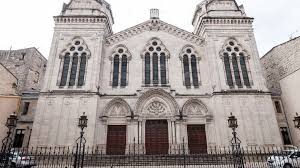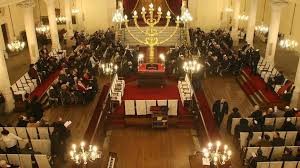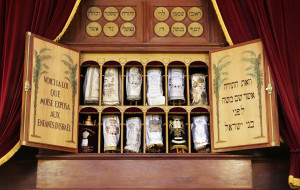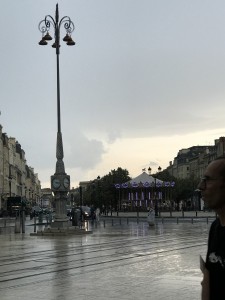 Bordeaux is famous for its red wine; canelés, a unique rum and vanilla flavored custard-like pastry with a caramelized crust; cepes, also called porcini, mushrooms; shopping; a vibrant red color and its large number of historic buildings among other things. In fact, Bordeaux has the largest number of preserved buildings of any city in France. It has also been designated as a UNESCO World Heritage Site. Set along a river as are most great cities, Bordeaux draws on the river, the ocean, and the countryside to define itself.
Bordeaux is famous for its red wine; canelés, a unique rum and vanilla flavored custard-like pastry with a caramelized crust; cepes, also called porcini, mushrooms; shopping; a vibrant red color and its large number of historic buildings among other things. In fact, Bordeaux has the largest number of preserved buildings of any city in France. It has also been designated as a UNESCO World Heritage Site. Set along a river as are most great cities, Bordeaux draws on the river, the ocean, and the countryside to define itself.
It is the sixth largest city in France, a country where size of population does not necessarily indicate importance. In fact, only one French city, Paris, has a core of over one million people although many other cities do have large metropolitan areas.
 Jewish history in Bordeaux goes back to at least the 6th century. The cemetery dates from 1072. However, as happened in most European cities, Jews were nominally expelled, but when the city was under English rule, some Jews were allowed to stay after paying a special tax. By the end of the 15th century, exiles from Spain and Portugal settled in the city, usually hiding their identities by outwardly acting like Christians.
Jewish history in Bordeaux goes back to at least the 6th century. The cemetery dates from 1072. However, as happened in most European cities, Jews were nominally expelled, but when the city was under English rule, some Jews were allowed to stay after paying a special tax. By the end of the 15th century, exiles from Spain and Portugal settled in the city, usually hiding their identities by outwardly acting like Christians.
 By 1790 as the spirit of reform moved across France, Jews were given the rights of citizens and there were even two Jews on the municipal council. After 5 years of construction, on September 5, 1882 the Great Synagogue was dedicated. Built in an eclectic ornamental style combining Romanesque and Byzantine elements common in European synagogues at the time, the sanctuary was especially notable for its size: it seats 1500 and has been called both the largest and most beautiful Sephardic synagogue in France. It is also the first synagogue to use a magen david as a decorative element. The metal columns supporting the second floor were fabricated in Gustav Eiffel’s workshop in Bordeaux.
By 1790 as the spirit of reform moved across France, Jews were given the rights of citizens and there were even two Jews on the municipal council. After 5 years of construction, on September 5, 1882 the Great Synagogue was dedicated. Built in an eclectic ornamental style combining Romanesque and Byzantine elements common in European synagogues at the time, the sanctuary was especially notable for its size: it seats 1500 and has been called both the largest and most beautiful Sephardic synagogue in France. It is also the first synagogue to use a magen david as a decorative element. The metal columns supporting the second floor were fabricated in Gustav Eiffel’s workshop in Bordeaux.
 During World War II, the building was used as a detention center and in 1944, the furniture was destroyed and the building pillaged by French Fascists. The building was restored some years later and has been declared a national monument. The Jewish community has a full slate of services including preschool, youth groups, adult education, and kosher food.
During World War II, the building was used as a detention center and in 1944, the furniture was destroyed and the building pillaged by French Fascists. The building was restored some years later and has been declared a national monument. The Jewish community has a full slate of services including preschool, youth groups, adult education, and kosher food.
Joan Nathan’s Quiches, Kugels and Couscous has some background information and recipes on food typical of Southwest France.
 We toured the city in a horrendous downpour which prepared us for the grey skies of the North. It’s been several days in Lille with rain every day and temperatures barely out of the 60s after the near 100 degrees in the southwest of France.
We toured the city in a horrendous downpour which prepared us for the grey skies of the North. It’s been several days in Lille with rain every day and temperatures barely out of the 60s after the near 100 degrees in the southwest of France.
The next installment of this French adventure will include the commemoration of the September 11, 1942 rafle in Northern France and the annual rentrèe after the weeks long vacation.
A selection of Jewish themed books set in France: (J indicates children’s books; F indicates fiction; NF indicates non-fiction)
- Dauvillier, Hidden: a child’s story of the Holocaust (J)
- Gidwitz, The Inquisitor’s Tale (J, all ages)
- McDonough, The Bicycle Spy (J)
- Morpurgo, Waiting for Anya (J)
- Polacco, The Butterfly (J)
- Strauss, The Hiding Game (J)
- Yolen, Stone Angel (J)
- Hannah, The Nightingale (F)
- Kamins, Complete Jewish Guide to France: a travel guide. Good general information although specific travel information may be dated. (NF)
- Kaminsky, Adolfo Kaminsky: a forger’s life (NF)
- Lipton, French Seduction: an American’s encounter with France, her father and the Holocaust (NF)
- Marrus, Vichy France and the Jews (NF)
- Nathan, Quiches, Kugels and Couscous: my search for Jewish cooking in France (NF)
- Ozick, Foreign Bodies (F)
- Is It Passover Yet? - Thu, Apr 18, 2024
- MESH Report April 9, 2024 - Thu, Apr 11, 2024
- Guess Who? - Wed, Mar 13, 2024
